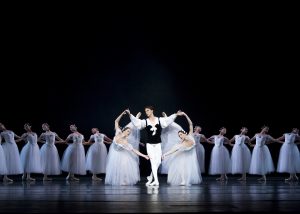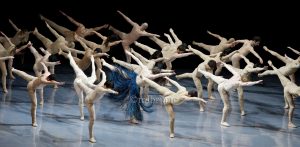De lichamen van Fokine, Van Manen en EGPC in het nieuwe programma ‘Corps’ van Het Nationale Ballet verschillen enorm, al dansen ze allen een vorm van ballet. Het zijn de verschillen qua inzet (decoratief of expressief, gestileerde controle of individuele overgave, vol van symboliek of daarvan ontdaan) en de sleutelrol voor het ensemble, die het programma buitengewoon interessant maken. Naast het feit dat EGPC op weg lijkt naar een artistieke doorbraak.

Tijdens de opening van het nieuwe programma ‘Corps’ kan het decoratieve ‘Les Sylphides’ van Fokine de toeschouwers maar net bekoren. Rachel Beaujean studeerde in 2004 bij HNB een nieuwe versie in, die minder sentimenteel en ’tuttig’ is dan gebruikelijk. Was het stuk in 1909 revolutionair vanwege het ontbreken van een verhaal, anno 2013 blijft het toch vooral een verhikel voor ‘schoon-dansen’.
‘Les Sylphides’ is favoriet bij balletbeoefenaars en -liefhebbers, maar hinkt desalniettemin op twee benen: het koor van dansers -corps de ballet- speelt een belangrijke rol in het distribueren van lijnen, volumes en ritmes in de ruimte. Als fascinerende verdubbelaar van kleine gestes komt het ensemble eigenlijk de hoofdrol toe. Maar Fokine voelde zich kennelijk gedwongen deze relatieve abstractie te combineren met een uitgekleed drama voor een dichter en drie muzen, een mini-koor dat uiteenvalt voor het dansen van duetten en andere schouwstukken met de dichter. Mocht deze kapstok ooit gewerkt hebben, heden doet het als een holle frase aan, een decoratieve plichtpleging, te meer daar danser Jozef Varga niet erg geïnspireerd lijkt. Toch intrigeert het ademende niets in tule gehuld. Het ‘naturel’ van Beaujean heeft de Syphides zeker goed gedaan.
Wanneer na de gebruikelijke pauze een mannelijk ‘corps de ballet’ het podium bezet, wordt duidelijk waarom de Fokine, los van populariteit, een plaats verdient in het programma. In ‘Corps’ uit 1985 draait Van Manen niet alleen de rollen om, maar verlegt hij op allerlei manieren de grenzen van het genre. De rol van een enkele sterdanser ontbreekt. Het gaat veel meer om dialogen tussen dansers en veel minder om esthetisch vertoon ten overstaan van een publiek.

In ‘Corps’ geen bevallig en zogenaamd onbevangen getrippel over de diagonaal. De mannen richten zich stoer en demonstratief tot het publiek. Frontaal zijn ook de relaties in de duetten met de drie danseressen, echte confrontaties die een uitwisseling van fysieke en emotionele krachten verbeelden. Ingenieus verbouwt Van Manen klassieke constructies, als een Escher van de neo-klassieke dans. In plaats van een wals van Chopin klinkt nu het expressionistische vioolconcert van Alban Berg, prachtig gespeeld door Liza Ferschtman. Het vervlechten en openbreken van klassieke lijnen en perspectieven wordt van accenten voorzien door dagelijkse gebaren en symbolische gestes. De expressie van de dansers is uitermate gestileerd, doorgecomponeerd. Toch blijft de ooit vernieuwende waarde van rondstappende danseressen en stampende dansers navoelbaar. Duetteren wordt duelleren. De dames laten zich door de mannen bepaald niet de kaas van het brood eten. Het ensemble heeft een onderlinge dynamiek die, hoe gestileerd of clichématig ook, nog steeds indruk maakt. De heropvoering van ‘Corps’ doet mijn Van-Manen-moeheid even verstommen. Dit is het moderne ballet waarmee hij ooit Nederland en de rest van de wereld veroverde.
Na deze historische terugblik is het tijd voor een hedendaags werk. Het duo Greco-Scholten, vroeger met EGPC aangeduid, runt sinds enkele jaren het choreografisch kunstencentrum ICK in Amsterdam. Ballet is vanaf de eerste werk ‘Bianco‘ in 1996 een referentiekader geweest en een terugkerende bron om uit te putten. In 2011 maakten EGPC bij Les Ballets de Monte-Carlo een voorstelling met tientallen balletdansers, ‘Le corps du ballet’, die nu herschreven is op het lichaam van Het Nationale Ballet.
Hoewel ‘het lichaam van het nationale ballet’ begint met een solo, is het principieel een groepsstuk. De danser danst niet alleen voor het publiek maar ook voor zijn collega’s. Het podium wordt een arena waar de dansers samenkomen. Als groep zijn zij niet alleen indrukwekkend, maar ook verontrustend. Het soort controle waar Fokine en Van Manen om vragen, wordt in dit stuk aan gruzelementen geslagen. In plaats van gestileerde lichamen in meer of minder veelzeggende poses en interacties, sturen Greco en Scholten de ruim dertig dansers het podium over met structuur, materiaal en inzet. De vorm die dat oplevert hangt af van wat de individuen er met zijn allen van maken.
Dit levert ineens een heel kwetsbaar ‘corps de ballet’ op. Het kan zich niet verschuilen achter voormannen of prima ballerina’s, in wiers schaduw het natuurlijk heel anders toeven is op de bühne. Gedurende enige tijd schermen ze hun gezichten af met lichte maskers. Zo hint EGPC naar de anomieme danser die normaliter het ensemble bevolkt, maar wordt ook de toeschouwer zich bewust wat er van een lichaam overblijft als het geen eigen kop mag opzetten. Niet dat het ensemble nu op de tast zijn weg moet vinden, maar ik stel mij voor dat het ook voor de dansers iets moet betekenen zo opgesloten te zijn in eigen bubble, tandpasta-smile of uitgestreken gezicht voor een moment opzij.
Haast aarzelend lijken de dansers zich aan de energie slurpende frasen van Greco over te geven. En opnieuw werkt de visuele verdubbelaar. Minder georganiseerd, meer als een textuur die opduikt uit het niets tussen de lichamen, ontstaan er steeds andere weefwerken van herhaalde, maar individuele ingezette armen en benen, houdingen en gestes, bewegingen en frases. Adembenemende wolken patroonweefsel worden door de dansers achtergelaten op het podium, gespiegeld in de subtiele projecties van Joost Rekveld. Wie het balletrepertoire en het oeuvre van EGPC in zijn achterzak heeft, zal de citaten herkennen. ‘het lichaam van het nationale ballet’ is een dubbele herwerking van repertoire. De dagelijkse kost van menig balletdanser wordt door Greco van een nieuwe energie, persoonlijke intenties, een andere omgang en een eigen inzet voorzien.

Vergeleken met eerder groepswerk van Emio Geco en Pieter Scholten doet ‘het lichaam van het nationale ballet’ veel lichter, minder dramatisch en opdringerig aan. De reële kwetsbaarheid van gezelschapsdansers die hun keurslijf moeten verlaten, en ook allicht de prille samenwerking tussen ICK en HNB zijn kennelijk een voordeel. Het is bijna jammer dat er nog hier en daar symbolische theatermiddelen opduiken. De existentialistiche boom, het blauwe licht van innerlijke verzinking dat aanzet tot opstandigheid – het zijn waarmerken van EGPC, net zoals de geluidsband vol symbolisch geluid, zoals hartslag, in het slot vallende deuren, denderend applaus en demonstratie-gejoel. Heerlijk zijn de explosieve beats, groots is ook de belichting van Henk Danner, wat geen kwaad kan na zoveel traditioneel ballet geweld, maar al met al roept het ook een vraag op.
Zijn de overduidelijke onderstrepingen van existentieel drama, Europese verwording en verlangen naar verzet eigenlijk wel nodig? De kaalheid van de groep, de kwestbaarheid van individuele dansers die niet meer van een vaste vorm kunnen uitgaan, is dat niet existentieel genoeg? Recent werk van choreografen als De Keersmaeker en Charmatz heeft aangetoond dat lyrische groepen niet alleen heel goed zonder vaste voormannen of -vrouwen kunnen, maar ook zonder dramatische belichting en symbolische props. In de ragfijne structuren van de choreografie ligt een rijkdom verborgen die, verder uitgewerkt, misschien wel een heel eigen rebellie zou kunnen opleveren. Hoe dan ook, ‘het lichaam van het nationale ballet’ blijft een prachtige afsluiting van een intrigerend drieluik met het ballet-ensemble, het corps du ballet, als rode draad.
‘Corps’ is tot en met 29 september te zien in het Muziektheater, Amsterdam.


